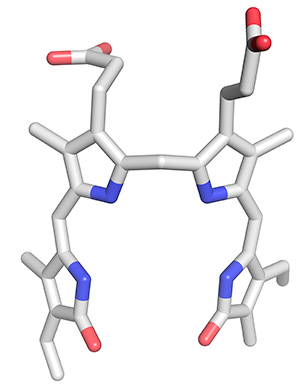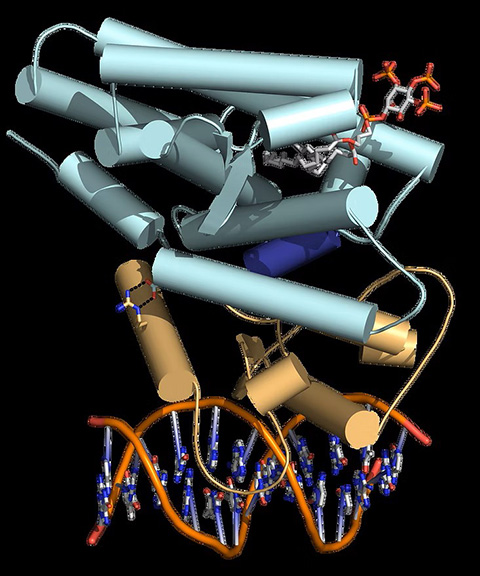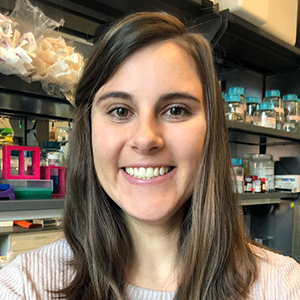Understanding the lipid link to gene expression in the nucleus
Proteins often get credit for doing all the work to relay messages in cells. But, lipids and sugars act as critical messengers too, helping turn genes on and off. When these nonprotein signals go awry, the consequences can include cancer, diabetes and developmental diseases. Ray Blind wants to know why.

Blind, an associate professor of cancer research at the Vanderbilt–Ingram Cancer Center in the Department of Medicine at Vanderbilt and a member of the Journal of Lipid Research editorial board, investigates how ligands bind and change the activity of two nuclear receptor 5A, or NR5A, family members called steroidogenic factor-1, or SF-1, and liver receptor homomlog-1, or LRH-1. These receptors help regulate processes that are vital for human health — including reproduction, hormone production and metabolism — making them central to understanding and potentially someday treating a wide range of diseases.
Blind recently discussed his research during ASBMB Breakthroughs, a webinar series featuring work from American Society for Biochemistry and Molecular Biology journals and sponsored by JLR. By dissecting the molecular mechanisms behind nonprotein nuclear signaling, Blind hopes to uncover how gene regulation goes awry in disease and how to fix it.
Looking for lipid ligands

Both SF-1 and LRH-1 rely on what Blind calls a “steric switch,” a structural change triggered by ligand binding. This conformational shift affects the recruitment of coregulators, altering gene expression.
“Because of this allosteric switch mechanism, these are really popular for drug design because they have a druggable ligand binding pocket,” Blind said.
Building on the work of biochemist Marion Sewer — for whom the ASBMB Marion B. Sewer Distinguished Scholarship for Undergraduates is named — Blind’s team used fluorescence anisotropy to track lipid interactions with SF-1. This method uses polarized light to analyze molecular interactions in solution.
They found that sphingomyelin and ceramide bound more tightly to SF-1 than lysosphingomyelin and sphingosine. This binding strength affected the recruitment of a transcription coregulator called DAX-1. Tighter-binding ceramide enhanced DAX-1 recruitment, while weaker-binding sphingosine did not.
DAX-1 and SF-1 coordinate adrenal and reproductive development, so understanding how ligands influence their interaction can shed light on how they work together to regulate these processes.
In contrast, LRH-1 was long considered an “orphan” receptor without any clear ligands. Recently, using a ligand screen, Blind’s team discovered that bilirubin, a byproduct of heme metabolism, binds LRH-1 and alters its interactions with transcriptional coregulators.
In liver and kidney human cell lines, bilirubin selectively regulated gene expression and notably downregulated cholesterol metabolism. Blind’s group is continuing to investigate the link between this heme byproduct and cholesterol synthesis to understand the implications for human disease.

Controlling genes via lipid modification
Another area of focus for Blind is the enzyme inositol polyphosphate multikinase, or IPMK, which phosphorylates nuclear lipids called phosphoinositides. Blind has been looking for the link between IPMK and gene regulation.
“If you lose this kinase (…) gene expression changes all over the place,” Blind said. “It hasn’t been 100% clear on how all that operates.”
IPMK’s phosphorylated inositol products were known to activate the enzyme histone deacetylase 3, or HDAC3, in laboratory settings. To test this in human cells, Blind’s team deleted IPMK from a brain cancer cell line and saw reduced HDAC3 activity, while other HDACs were unaffected.
Restoring IPMK or adding its inositol products reactivated HDAC3 activity. Blind’s team observed the same phenomenon in noncancerous cells. Since aberrant HDAC3 activity is tied to liver and lung cancers — and drug resistance can reduce HDAC3 therapy effectiveness — targeting IPMK may offer an alternative treatment.
“That's pretty convincing to me that … IPMK inhibitors might in a biomedical sense enhance the selectivity of HDAC3 selective inhibitors in various cancers,” Blind said.
If you missed it, here's the full Breakthroughs webinar.

Up next
Chemical approaches to sorting out histone modifications
Aug. 13, 2025, 12:15–1 p.m. Eastern
Philip Cole of Brigham and Women’s Hospital will present his research into the influence of histone modifications on enzyme recognition and processing.
Register for the webinarEnjoy reading ASBMB Today?
Become a member to receive the print edition four times a year and the digital edition monthly.
Learn moreGet the latest from ASBMB Today
Enter your email address, and we’ll send you a weekly email with recent articles, interviews and more.
Latest in Science
Science highlights or most popular articles

Building the blueprint to block HIV
Wesley Sundquist will present his work on the HIV capsid and revolutionary drug, Lenacapavir, at the ASBMB Annual Meeting, March 7–10, in Maryland.

Gut microbes hijack cancer pathway in high-fat diets
Researchers at the Feinstein Institutes for Medical Research found that a high-fat diet increases ammonia-producing bacteria in the gut microbiome of mice, which in turn disrupts TGF-β signaling and promotes colorectal cancer.

Mapping fentanyl’s cellular footprint
Using a new imaging method, researchers at State University of New York at Buffalo traced fentanyl’s effects inside brain immune cells, revealing how the drug alters lipid droplets, pointing to new paths for addiction diagnostics.

Designing life’s building blocks with AI
Tanja Kortemme, a professor at the University of California, San Francisco, will discuss her research using computational biology to engineer proteins at the 2026 ASBMB Annual Meeting.

Cholesterol as a novel biomarker for Fragile X syndrome
Researchers in Quebec identified lower levels of a brain cholesterol metabolite, 24-hydroxycholesterol, in patients with fragile X syndrome, a finding that could provide a simple blood-based biomarker for understanding and managing the condition.

How lipid metabolism shapes sperm development
Researchers at Hokkaido University identify the enzyme behind a key lipid in sperm development. The findings reveal how seminolipids shape sperm formation and may inform future diagnostics and treatments for male infertility.

